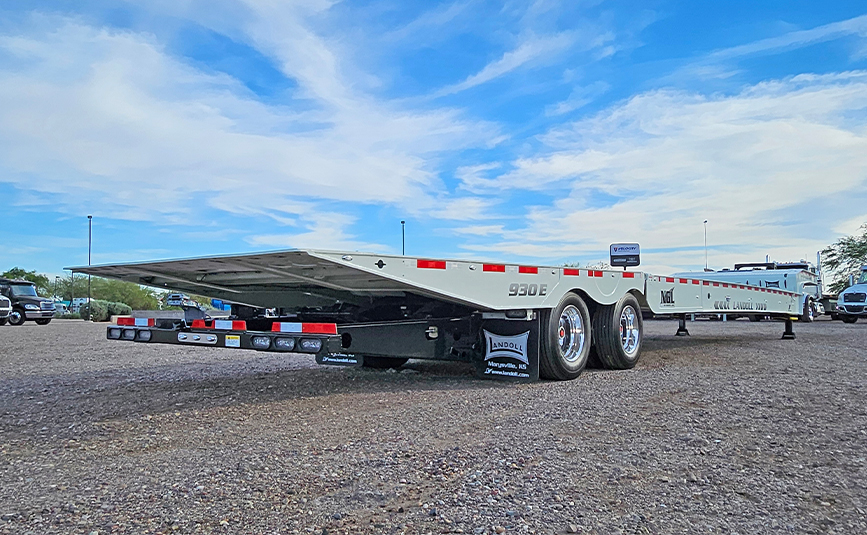A traveling axle and a hydraulic tail are two loading systems used on heavy-equipment trailers, but they function very differently. Both aim to simplify loading, improve safety, and reduce dependence on traditional ramps—yet the mechanics, applications, and advantages are not the same. Understanding these differences ensures you choose the right trailer for your equipment and hauling demands.

What Is a Traveling Axle?
A traveling axle trailer uses a hydraulic system to slide the entire axle group toward the rear of the trailer. As the axles shift backward, the deck gradually slopes to the ground, creating a full-length loading angle.
This gives you:
-
A low, controlled loading incline
-
Full-deck loading access
-
Ability to load low-clearance equipment
-
Ideal for uneven jobsite surfaces
Traveling axle systems are commonly found on Landoll 440/455/930 series trailers, Brandt travelling axle models, and comparable “sliding axle” equipment haulers.

What Is a Hydraulic Tail?
A hydraulic tail trailer uses a rear-mounted hydraulic ramp assembly that folds down to create a loading approach. The tail lifts, lowers, and sometimes folds, depending on design.
You get:
-
Fast, simple loading
-
Shorter overall loading footprint
-
Higher loading speed for frequent cycles
-
Lower maintenance compared to sliding-axle systems
This system is typically found on Landoll 930E hydraulic tail trailers, XL Specialized HT models, and many paver-friendly trailers requiring fast ground contact.

Key Differences at a Glance
| Feature | Traveling Axle | Hydraulic Tail |
|---|---|---|
| Loading Angle | Extremely low | Moderate |
| Best For | Low-clearance machinery, forklifts, sweepers, scissor lifts | Skid steers, pavers, compact equipment |
| Speed of Operation | Slower | Faster |
| Deck Control | Full-deck tilt | Tail-only movement |
| Maintenance | More hydraulic components | Fewer moving parts |
| Stability on Uneven Ground | High | Moderate |
| Load Placement | Very precise | Good, but less precise than full tilt |
When to Choose a Traveling Axle
Choose a traveling axle trailer when you need maximum loading flexibility and the lowest possible loading angle. These shine in:
-
Equipment rental operations
-
Material-handling loads (forklifts, telehandlers, manlifts)
-
Machinery with very low ground clearance
-
Jobsites with uneven or soft ground
-
Situations requiring full-deck tilt for precise positioning
If you load multiple types of mixed equipment every day, a traveling axle is the most versatile tool in the yard.
When to Choose a Hydraulic Tail
A hydraulic tail is the right choice when loading speed matters more than extreme tilt capability. These trailers excel in:
-
Paver and paving-equipment transport
-
Daily construction hauling with smaller machines
-
Frequent load/unload cycles
-
Operations needing a simple, rugged design
-
Jobs with consistent ground surfaces
Because the hydraulic tail operates independently from the deck, it offers faster cycle times and lower long-term maintenance.
Pros and Cons of Each System
Traveling Axle – Advantages
-
Lowest loading angle in the industry
-
Best for low-clearance loads
-
Full-deck access and tilt
-
High load stability
Traveling Axle – Drawbacks
-
More hydraulic components → more maintenance
-
Slower loading cycle
-
Heavier empty weight
Hydraulic Tail – Advantages
-
Very fast load/unload process
-
Reduced maintenance vs. sliding axles
-
Strong rear structure for repeated loading
-
Excellent for pavers and compact equipment
Hydraulic Tail – Drawbacks
-
Higher loading angle
-
Not ideal for extremely low machines
-
Tail requires room to deploy
Which Is Better?
There is no universal winner—your application decides:
-
Frequent mixed equipment + low clearance: Traveling axle wins.
-
High-volume loading cycles + pavers or compact machines: Hydraulic tail is the smarter choice.
-
Rough jobsite terrain: Traveling axle offers better stability.
-
Strict budgets and lower maintenance: Hydraulic tail.
Real-World Examples of Each
Traveling Axle Trailers:
Hydraulic Tail Trailers:
- These are the exact types used by contractors, equipment rental fleets, utility companies, and paving crews across the U.S.




